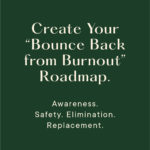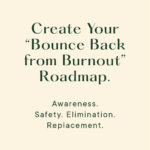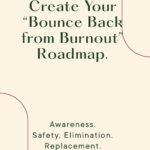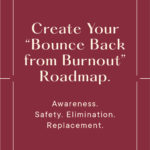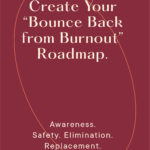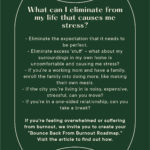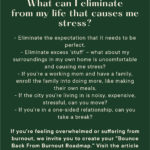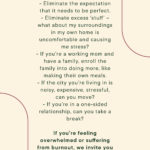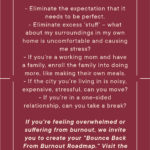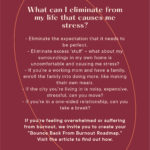Over-extended A-type women are exhausted. I know because I’ve been one of them and now do Integrated Nutrition Health Coaching to help them get back to healthy.
If you’re feeling at the end of your rope and you just can’t cope, try creating a custom roadmap for yourself with our outline below. While it doesn’t have a catchy title or acronym, your steps are Awareness, Safety, Elimination, and Replacement. Read on to craft yours. And if you’d like group or 1:1 coaching, you can always sign up for Your Daily™ where we have health coaches on the other end to support you.
Awareness
Do you vacillate between feeling nothing and everything? Would you say maybe you’re red-lining? Meaning, your emotions are right at the surface and the slightest thing throws you over the edge into rage, frustration, hopelessness, or depression?
Most overextended high-achieving women that I coach tell me unequivocally: yes. They’ve had it up to “here” and they can’t take it anymore.
But they don’t know exactly what “it” is. Everything feels like a dumpster fire. Everything feels like a trigger and all they know is that they’re swimming in a world of people who are inept and unhelpful.
Everything feels like a dumpster fire. Everything feels like a trigger and all they know is that they’re swimming in a world of people who are inept and unhelpful.
This, friend, is what we call burnout. Burnout is real and it means we’ve exhausted our internal resources and our body is running in survival mode. The short temper, the inability to access feelings (other than anger or sadness), and our inability to stabilize quickly after an event are all ways our body is trying to communicate to us.
This is why we focus on Awareness first. Awareness helps us to find a pattern. It helps us discover things about ourselves and our lens on life that is coloring our experience of the world, for good or bad.
What to Do:
Pay attention to when you feel triggered. Any time an experience happens and you instantly feel a rush of adrenaline or a surge of sadness, hurt, or exasperation.
For each trigger ask “why” as if you were a two-year-old on a truth expedition. Ask Why do I feel this way? What was the reason behind the reason? To do this, we ask ourselves WHY. You’re going to drill down on the “why” quite a few times — up to 7 times.
Once you feel you cannot go any further with your “why” questioning, ask “what do I believe?”
EXAMPLE:
“I’m triggered when people lie to me.”
- Why? I detest when someone is dishonest.
- Why? I believe most people have an agenda.
- Why? I saw it happen to my parents in their divorce and it’s been true my whole life after that.
- What do I believe? Most people are dishonest and hide their real feelings.
- What do I believe? People should be honest and transparent in their needs and wants with each other.
The natural progression to alter this behavior would be to change your thoughts about people or start to lead a very transparent life. However, this is real life and stuff like that is HARD.
It’s hard because we’ve lived a life firing the same brain synapses over and over again, and so flipping a switch to start thinking differently takes a lot of effort. Beyond the effort, it’s scary because it’s “unknown” to us. Our bodies are hard-wired to conserve energy and not do anything scary.
This leads us to the next step: Creating Safety.
Safety
Our body’s main objective in this life is survival. It speaks in binary terms: safe or unsafe. When it deems something unsafe, certain cognitive behaviors go offline and our primal self takes over. Decision-making and logic, which are done in a different part of our brain, are typically offline when we’re feeling unsafe. Being aware of this fact alone will help you forgive yourself for some of your panicked and possibly irrational behaviors.
Some people can feel unsafe for years or even decades because of internal programming that happened early in life. Our goal in all situations is to find awareness then find a way to bring ourselves back to feeling safe.
What to Do:
How can you find your way back to safety?
It’s important to find a physical release for this energy. Going for a run or a brisk walk, hitting a punching bag, or dancing around in your room are great ways to help release the energy and cater to your fight or flight response, but the goal of anger is more than just to release energy.
After physically expending the anger it can help to do some visualizations of the people or things that are stressing you out. Imagine telling them to leave you alone. In your mind’s eye, see them walk away and feel the peace left in their wake. Even mentally placing something between you and them can help you to feel protected and safe.
Playing some music or making sure to give yourself a hug and a big smile can finalize the emotions that were stored in your body and bring you back to your safe natural state, ready to take on the world.
So next time you’re feeling angry at your boss or pissed off at something you read on social media, take a break, express the anger (not at the person who caused it) and then do some visualizations and self-soothing. One way we can do this is by excusing ourselves to the bathroom and do air punches or shaking to release the energy.
While sounding possibly ridiculous or childish, your mind, and body will thank you.
Elimination
Once you’ve found what your triggers are and you can access safety, it’s time to eliminate the stressors. Elimination can be permanent or temporary. It’s up to you to understand if you’re done, or if you just need a break to get back to yourself first.
In gut health, this means eliminating the toxins, pathogens, and foods that are irritating you. You can read about that here.
In your everyday life, we’re looking to eliminate people, places, or things that continually cause distress and eruptions. Many people like to say draw boundaries, however, in our experience, we’ve discovered that creating boundaries for people-pleasers is a very challenging and stressful process. Not for the faint at heart.
Sometimes the best boundary we can draw is elimination until you’re strong enough to regulate yourself if that trigger were to be in your life consistently.
What to Do:
What can I eliminate in my life that causes me stress?
- The lowest hanging fruit is often to eliminate the expectation that it needs to be perfect.
- Another easy elimination is ‘stuff’ – what about my surroundings in my own home is uncomfortable and causing me stress? Donate that stack of books in the corner. Clean out the drawer in the kitchen that is so full it gets stuck every time you open it.
- If you’re a working mom and have a family, enroll the family into doing more, like making their own meals.
- If the city you’re living in is noisy, expensive, stressful, can you move?
- If you’re in a one-sided relationship, can you take a break?
Replacement
Now that you’re finding some breathing room in your life either physically or emotionally, or ideally both – it’s time to evaluate to discover if you need any replacement pieces.
What to Do:
Can you replace your old nighttime routine of watching TV and cleaning up for 20 minutes of yin yoga and journaling?
Can you replace the obligatory lunches with people you didn’t like for a walk by yourself?
Can you replace the stacks of unread books and magazines with a library card?
Can you replace the junk food stash in your pantry with quick, healthy bites?
Replacing something isn’t always necessary. The point of clearing our plate to only put more on it is not the goal – our intention is to find meaningful exchanges that fill up your cup rather than suck you dry.
The fact that you’re here and looking for support is the biggest piece of this puzzle. It means you are curious about yourself, how you got here and that you’re ready for action. You got this!
And if you’re looking at this list and thinking you might want to investigate further, read up on our own RESET process.







